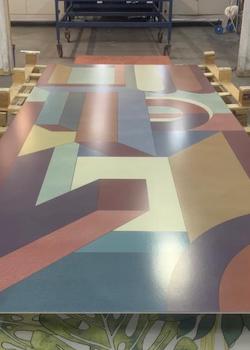In the One-to-One column, NTCA Executive Director Bart Bettiga interviews industry leaders about pertinent topics. Watch the interview on the NTCA YouTube channel.


Joe Lundgren has been involved in the tile industry in a variety of roles for more than 40 years. From working in a warehouse at American Olean to serving as Vice President of Marketing for Dal-Tile LLC, Joe has a unique understanding of the U.S. tile market. For the past 11 years, Joe has supported clients through his company, Joe Lundgren Consulting
(joelundgrenconsulting.com), specializing in business development, product management, and marketing. We caught up with Joe to discuss the economy and how it affects the U.S. tile industry, as well as product trends tile installers can expect to see in 2023 and beyond.
Tell us about the type of work you do in your consulting business.
I work with companies in many areas related to business and product development, from importers and distributors who purchase globally, to foreign and domestic manufacturers who look at the U.S. tile market as a key strategic objective. Important decisions need to made by companies looking to do business in our country, and I play a consulting role helping them to determine what the best course of action is for them.
What are your thoughts on economic conditions for the U.S. tile market ending 2022 and looking into 2023?

When I look at how tile is performing, I look at housing, the LIRA (Leading Indicator of Remodeling Activity) and the ABI (Architectural Billings Index) for commercial analysis. This usually gives me a great indication of what will happen to the tile market. But there are other factors to consider as well. In 2022, I think tile will end the year flat as compared to 2021 in terms of volume or sales per square foot, but some of that was skewed because many importers beefed up their inventory levels for fear of rising prices in Europe due to the war in Ukraine and supply issues associated with difficulties to get materials through the ports.
Rising prices did impact the tile market in terms of dollars. We will end the year about 15-20% higher in terms of dollar volume because of these issues. Prices will still fluctuate even though the port crisis has stabilized, due to high costs in manufacturing and shipping. The good news on that front is it does appear that ocean freight costs from exporters seem to be getting back to more manageable levels as compared to earlier in 2022, helping ease the costs to importers.
One thing to look for in 2023 is that importers will continue to find alternate sources for tile supply, with countries like Vietnam, Malaysia, India and others taking on a more significant role in the U.S. tile industry. Domestic factories continue to flourish in this market, and I only see this trend continuing.
How is ceramic tile performing against competitive products like carpet, wood and LVT/LVP?
One thing to remember is that U.S. per capita use of tile is still very low compared to other industrialized nations. We have a lot of opportunity to put ceramic tile in a lot of places, for floors and walls in both interior and exterior applications in residential and commercial installations. We still have work to do to educate the consumer and specifier about the benefits of tile. This is changing, and we are selling more tile in more creative applications than many years ago, but we still have so much opportunity to grow.
Improvements in manufacturing in the LVT/LVP category have had a negative impact on the tile industry. They still struggle to compete with tile as it relates to design and versatility, but if they incorporate ink jet technology effectively it will be something to be concerned about.
What new product trends coming from exporters shipping tile to the U.S. are you seeing that you think can positively impact our industry?
First, I see prices overall as stabilizing or perhaps even going down in some instances. Because of inflation and higher interest rates I do think you will see more people looking to purchase low-priced commodity tile in more instances than we have seen the past few years.
As far as manufacturing trends, the gauged porcelain tile panel market continues to grow and those investing in this in distribution and installation are starting to reap the benefits. There is no doubt that panels are going to become a bigger part of our market. I congratulate NTCA and other industry leaders for getting out in front of this and offering training and education on this important category. This includes both thin panels and now the 2cm and 3cm products that are exploding in popularity for exterior applications as well. The countertop market is also a huge opportunity for porcelain tile, and fabricators are becoming aware of these opportunities too. I don’t think panels are more than 5% of the tile market right now, but the potential is there for those willing to invest in them.






How is distribution evolving and what impact is that having on the tile market?
I used to say there were three traditional channels of distribution or how tile gets to market here in the U.S.: home centers (Home Depot, Lowes,etc.) company-owned stores (Dal-Tile, Florida Tile, Crossville, etc.) and independent distributors with one or multiple locations. The independents were primarily family-owned businesses with established legacies. Companies that haven’t changed their systems and processes are struggling.
What I am seeing now is the emergence of a fourth category of what I call the mega-distributors. They either have a strong footprint in their region or they are going national and expanding. I think now even a fifth category is being created. This is the specialty retail companies, and I see only The Tile Shop and Floor & Decor fitting into this as of today. These companies have identified the professional tile contractor as a primary customer because they realize they influence the consumer on where to shop for and buy tile. Home centers are starting to focus on this approach as a reaction to the success of these companies, but this will be a difficult road for them to navigate. Independent distributors are an important component of our industry, and they have new challenges to overcome, so it will be interesting to see how they evolve as it relates to mergers and acquisitions, and competing in the industry that now has five channels of distribution.
Bart Bettiga is the Executive Director of the National Tile Contractors Association. Bettiga is a member of the Board of Governors of Coverings, one the largest tradeshows in North America. He has over 30 years of experience in the tile and stone industry and has served as the NTCA Executive Director since 2002. He is a well known speaker and author on ceramic tile and natural stone distribution and installation. He oversees the financial operations of the NTCA, TileLetter and the Ceramic Tile Education Foundation.








